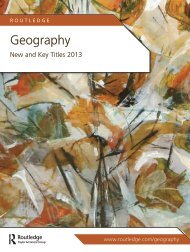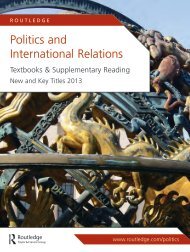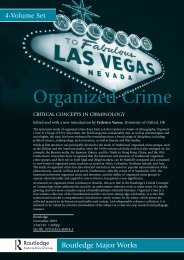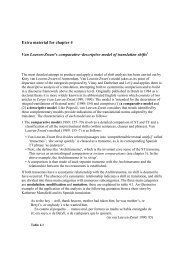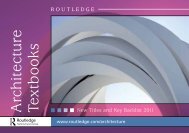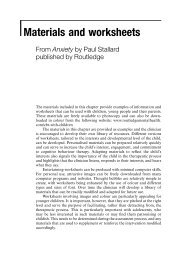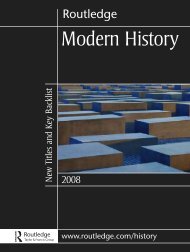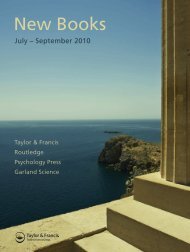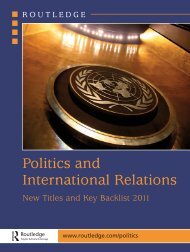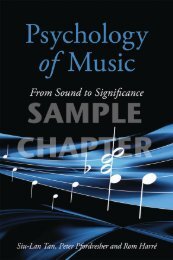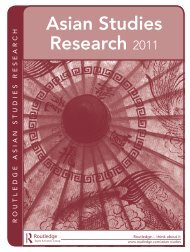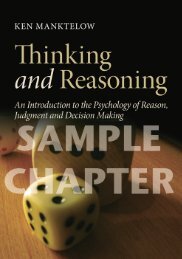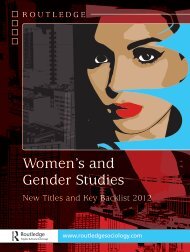Tim Burton: The Monster and the Crowd - A Post-Jungian Perspective
Tim Burton: The Monster and the Crowd - A Post-Jungian Perspective
Tim Burton: The Monster and the Crowd - A Post-Jungian Perspective
Create successful ePaper yourself
Turn your PDF publications into a flip-book with our unique Google optimized e-Paper software.
16 Introduction<br />
admission, his creative process is more intuitive than intellectual: `I don't<br />
trust my intellect as much, because it's kind of schizy,' <strong>Burton</strong> admits, `I<br />
feel more grounded going with a feeling' (Woods, 2002: 41). He starts with<br />
a vague image, <strong>and</strong> goes on to create a numinous symbol which often has<br />
personal signi®cance for him, such as a dishevelled boy with scissors instead<br />
of h<strong>and</strong>s, a rugged madman who calls himself a `bio-exorcist', a menacing<br />
urban panorama, a spooky countryside l<strong>and</strong>scape. <strong>The</strong> image of Edward<br />
Scissorh<strong>and</strong>s, for instance, `came subconsciously <strong>and</strong> was linked to a character<br />
who wants to touch but can't; who was both creative <strong>and</strong> destructive<br />
...Itwasvery much linked to a feeling' (Salisbury, 2006: 87).<br />
However, <strong>Burton</strong>'s habit of reworking existing narratives does not<br />
indicate a lack of creativity or de®ciency of imagination. It is true that he<br />
prefers to work with popular myths, but gives <strong>the</strong>m a new visual interpretation.<br />
His versions of pre-existent symbols ± <strong>the</strong> Joker, Batman, Willy<br />
Wonka, Topps Cards Martians, talking apes, Sweeney Todd ± if <strong>the</strong>y do<br />
not always outshine <strong>the</strong> original, are never<strong>the</strong>less instantly recognisable <strong>and</strong><br />
visually striking. Moreover, <strong>the</strong> distinctiveness <strong>and</strong> numinosity of his<br />
symbols compensate for <strong>the</strong> inadequacy of technical <strong>and</strong> narrative elements.<br />
With Edward Scissorh<strong>and</strong>s for a central character, one cannot<br />
lament <strong>the</strong> absence of a clever rhythmic pattern, inventively striking juxtapositions<br />
or intriguingly non-linear narrative. However eloquent <strong>and</strong><br />
beautiful <strong>the</strong>se tricks can be, <strong>Tim</strong> <strong>Burton</strong> simply does not need <strong>the</strong>m to get<br />
his message across. When he wants to tell a story ± his story ± he does not<br />
re®ne it until it becomes a shiny, robotic work of art. He leaves it in a<br />
vaguely raw, half-unconscious (his hallmark), twilight state, devoid of <strong>the</strong><br />
smoothness of <strong>the</strong> classic narrative ®lm on <strong>the</strong> one h<strong>and</strong>, <strong>and</strong> <strong>the</strong> sharp<br />
precision of thought which is so typical of intellectual ®lmmaking on <strong>the</strong><br />
o<strong>the</strong>r. <strong>The</strong>re is enough power in Edward to charge <strong>the</strong> ®lm with energy <strong>and</strong><br />
poignancy. <strong>The</strong> creature with scissors is multi-layered <strong>and</strong> complex enough<br />
as a symbol to invite multiple, <strong>and</strong> con¯icting, interpretations.<br />
To sum up <strong>the</strong> ideas discussed on <strong>the</strong> previous pages ± <strong>Burton</strong> looks as<br />
unnatural in <strong>the</strong> `highbrow' corner as he does among <strong>the</strong> gang of `meaningless<br />
action' directors. All <strong>the</strong> while, his style is unique <strong>and</strong> easily recognisable,<br />
with repeating visual <strong>and</strong> narrative patterns. He tends to neglect <strong>the</strong><br />
textual aspect of ®lm; <strong>and</strong> in doing this, he places `<strong>the</strong> image' higher than<br />
`<strong>the</strong> word'. Consequently, <strong>the</strong> cinematic, `moving' narrative suffers alongside<br />
<strong>the</strong> textual aspect (storyline, dialogues, extradiegetic voices). In addition,<br />
he predominantly operates with simple, myth-like compositions. His<br />
®lms foreground `bigger' symbolism at <strong>the</strong> expense of syntactic intricacy<br />
<strong>and</strong> diegetic ploys, <strong>and</strong> gravitate towards intense <strong>and</strong> vivid, but less<br />
detailed, models <strong>and</strong> blocks. This inevitably steers <strong>Burton</strong>'s creative vision<br />
towards <strong>the</strong> realm of <strong>the</strong> fantastic, where such means of expression are<br />
appropriate, while almost totally neglecting realistic genres. <strong>Burton</strong> certainly<br />
feels `at home' with a number of traditionally popular genres such as<br />
http://www.jungarena.com/tim-burton-<strong>the</strong>-monster-<strong>and</strong>-<strong>the</strong>-crowd-9780415489713



